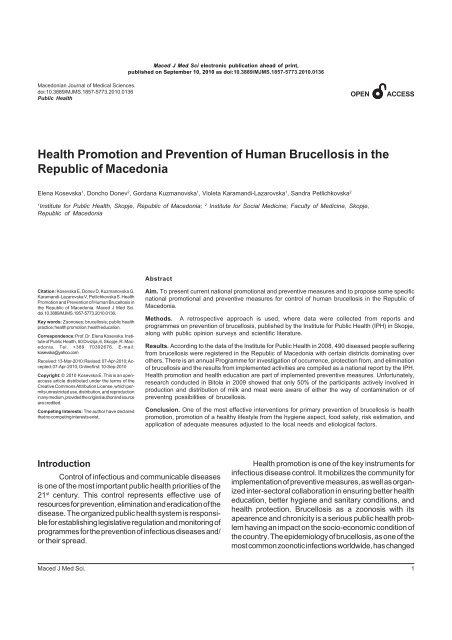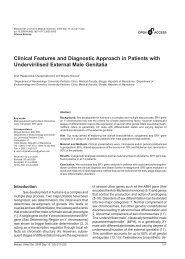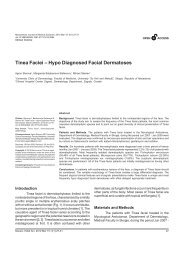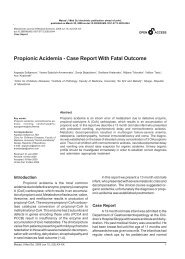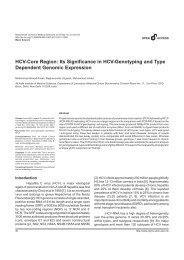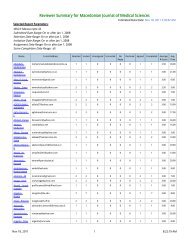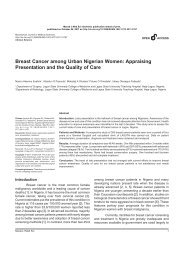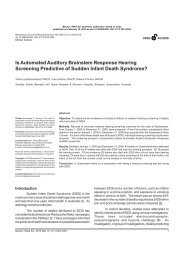OnlineFirst Full-Text PDF - Macedonian Journal of Medical Sciences
OnlineFirst Full-Text PDF - Macedonian Journal of Medical Sciences
OnlineFirst Full-Text PDF - Macedonian Journal of Medical Sciences
Create successful ePaper yourself
Turn your PDF publications into a flip-book with our unique Google optimized e-Paper software.
Maced J Med Sci electronic publication ahead <strong>of</strong> print,<br />
published on September 10, 2010 as doi:10.3889/MJMS.1857-5773.2010.0136<br />
Kosevska et al. Health Promotion in Brucellosis Prevention<br />
<strong>Macedonian</strong> <strong>Journal</strong> <strong>of</strong> <strong>Medical</strong> <strong>Sciences</strong>.<br />
doi:10.3889/MJMS.1857-5773.2010.0136<br />
Public Health<br />
OPENACCESS<br />
Health Promotion and Prevention <strong>of</strong> Human Brucellosis in the<br />
Republic <strong>of</strong> Macedonia<br />
Elena Kosevska 1 , Doncho Donev 2 , Gordana Kuzmanovska 1 , Violeta Karamandi-Lazarovska 1 , Sandra Petlichkovska 2<br />
1<br />
Institute for Public Health, Skopje, Republic <strong>of</strong> Macedonia; 2 Institute for Social Medicine; Faculty <strong>of</strong> Medicine, Skopje,<br />
Republic <strong>of</strong> Macedonia<br />
Abstract<br />
Citation: Kosevska E, Donev D, Kuzmanovska G,<br />
Karamandi-Lazarovska V, Petlichkovska S. Health<br />
Promotion and Prevention <strong>of</strong> Human Brucellosis in<br />
the Republic <strong>of</strong> Macedonia. Maced J Med Sci.<br />
doi.10.3889/MJMS.1957-5773.2010.0136.<br />
Key words: Zoonoses; brucellosis; public health<br />
practice; health promotion; health education.<br />
Correspondence: Pr<strong>of</strong>. Dr. Elena Kosevska. Institute<br />
<strong>of</strong> Public Health, 50 Divizija, 6, Skopje, R. Macedonia.<br />
Tel. +389 70392676. E-mail:<br />
kosevska@yahoo.com<br />
Received: 13-Mar-2010; Revised: 07-Apr-2010; Accepted:<br />
07-Apr-2010; Online first: 10-Sep-2010<br />
Copyright: © 2010 Kosevska E. This is an openaccess<br />
article distributed under the terms <strong>of</strong> the<br />
Creative Commons Attribution License, which permits<br />
unrestricted use, distribution, and reproduction<br />
in any medium, provided the original author and source<br />
are credited.<br />
Competing Interests: The author have declared<br />
that no competing interests exist.<br />
Aim. To present current national promotional and preventive measures and to propose some specific<br />
national promotional and preventive measures for control <strong>of</strong> human brucellosis in the Republic <strong>of</strong><br />
Macedonia.<br />
Methods. A retrospective approach is used, where data were collected from reports and<br />
programmes on prevention <strong>of</strong> brucellosis, published by the Institute for Public Health (IPH) in Skopje,<br />
along with public opinion surveys and scientific literature.<br />
Results. According to the data <strong>of</strong> the Institute for Public Health in 2008, 490 diseased people suffering<br />
from brucellosis were registered in the Republic <strong>of</strong> Macedonia with certain districts dominating over<br />
others. There is an annual Programme for investigation <strong>of</strong> occurrence, protection from, and elimination<br />
<strong>of</strong> brucellosis and the results from implemented activities are compiled as a national report by the IPH.<br />
Health promotion and health education are part <strong>of</strong> implemented preventive measures. Unfortunately,<br />
research conducted in Bitola in 2009 showed that only 50% <strong>of</strong> the participants actively involved in<br />
production and distribution <strong>of</strong> milk and meat were aware <strong>of</strong> either the way <strong>of</strong> contamination or <strong>of</strong><br />
preventng possibilities <strong>of</strong> brucellosis.<br />
Conclusion. One <strong>of</strong> the most effective interventions for primary prevention <strong>of</strong> brucellosis is health<br />
promotion, promotion <strong>of</strong> a healthy lifestyle from the hygiene aspect, food safety, risk estimation, and<br />
application <strong>of</strong> adequate measures adjusted to the local needs and etiological factors.<br />
Introduction<br />
Control <strong>of</strong> infectious and communicable diseases<br />
is one <strong>of</strong> the most important public health priorities <strong>of</strong> the<br />
21 st century. This control represents effective use <strong>of</strong><br />
resources for prevention, elimination and eradication <strong>of</strong> the<br />
disease. The organized public health system is responsible<br />
for establishing legislative regulation and monitoring <strong>of</strong><br />
programmes for the prevention <strong>of</strong> infectious diseases and/<br />
or their spread.<br />
Health promotion is one <strong>of</strong> the key instruments for<br />
infectious disease control. It mobilizes the community for<br />
implementation <strong>of</strong> preventive measures, as well as organized<br />
inter-sectoral collaboration in ensuring better health<br />
education, better hygiene and sanitary conditions, and<br />
health protection. Brucellosis as a zoonosis with its<br />
apearence and chronicity is a serious public health problem<br />
having an impact on the socio-economic condition <strong>of</strong><br />
the country. The epidemiology <strong>of</strong> brucellosis, as one <strong>of</strong> the<br />
most common zoonotic infections worldwide, has changed<br />
Maced J Med Sci.<br />
1
Public Health<br />
over the past decade because <strong>of</strong> various socioeconomic,<br />
political, sanitary and other reasons [1]. Although brucellosis<br />
can be found worldwide, it is more common in<br />
countries that have not implemented good standardized<br />
and effective public health measures for prevention and<br />
where the programmes for control <strong>of</strong> the disease have not<br />
resulted in a decrease in its incidence among animals.<br />
Areas currently listed as high risks are: Portugal, Spain,<br />
Southern France, Italy, Greece, Turkey, North Africa,<br />
South and Central America, Eastern Europe, Asia, Africa,<br />
the Caribbean and the Middle East [2].<br />
To present current national promotional and preventive<br />
measures and to propose national promotional and<br />
preventive measures for control <strong>of</strong> human brucellosis in the<br />
Republic <strong>of</strong> Macedonia, adapted to local and regional<br />
conditions.<br />
Material and Methods<br />
A retrospective and analytical approach was used,<br />
where statistical data and information about brucellosis<br />
prevalence were collected from annual reports and national<br />
programmes on the prevention <strong>of</strong> brucellosis, published<br />
by the Institute for Public Health in Skopje.<br />
A survey in Bitola, conducted in May 2009, was<br />
used to evaluate the level <strong>of</strong> knowledge and practice, as<br />
well as information about brucellosis, its etiology, clinical<br />
picture, consequences. The study was conducted on a<br />
sample <strong>of</strong> 200 respondents, <strong>of</strong> which 70 were high school<br />
students, 30 were employees in the meat and milk<br />
production industry, 50 were employees in premises for<br />
trading meat, milk and their products and 50 were consumers.<br />
A multiple-choice questionnaire with 14 questions<br />
was administered. The data were statistically processed<br />
and present the percentage distribution <strong>of</strong> frequency<br />
<strong>of</strong> the disease. For comparative analysis, national<br />
and international scientific literature was reviewed.<br />
abortions in pigs and Brucella neotomae, Brucella ovis<br />
and Brucella canis. The last 3 species, especially Brucella<br />
melitensis, are important in their epizootologic and<br />
epidemiologic aspect in the Republic <strong>of</strong> Macedonia and in<br />
the world. Compared to other entero-pathogenic bacteria,<br />
Brucellas are among the most resistant forms that can live<br />
for 10 or more days in milk, 20 days in water, or even more<br />
than 2 months in clothes contaminated with urine from<br />
diseased animals. In products made from non-pasteurized<br />
milk, brucellas maintain their infective capacity for<br />
several months. All Brucellas are sensitive to direct<br />
sunlight, high temperature, pasteurization and some disinfectants.<br />
In animals, Brucella causes a non-apparent infection<br />
during which infected animals constantly secret<br />
bacteria through vaginal secretions, urine and milk. Clinically,<br />
the disease manifests itself gravely only in the form<br />
<strong>of</strong> abortion. These animals are highly infective during the<br />
abortions, through the infected embryo, the placenta and<br />
the placental fluid.<br />
Human brucellosis - routes <strong>of</strong> infections and<br />
clinical presentation. The main mechanisms for infection<br />
<strong>of</strong> people are alimentary, contact (involving skin and<br />
conjunctivas), and inhalation through the upper respiratory<br />
tract. The incubation lasts from 7 to 14 days. The disease<br />
is characterized by a recurrent temperature, sweating and<br />
aches, especially in joints, bones and muscles. In humans,<br />
it involves the reticulo-endothelial system, so<br />
lymphadenitis with enlarged spleen and liver is <strong>of</strong>ten seen.<br />
Pathognomonical signs <strong>of</strong> the disease are orchitis, vertebral<br />
osteomielitis and prepatelar bursitis. Untreated brucellosis<br />
is characterized by infection <strong>of</strong> joints, heart<br />
muscle, mitral and aortal valves, sterility and a chronic<br />
outcome frequently complicated with invalidity. Infection<br />
<strong>of</strong> humans is correlated to intensity <strong>of</strong> epizooty among<br />
domestic animals. Much less frequently, ill humans could<br />
be a source <strong>of</strong> infection.<br />
Results<br />
Public health aspects <strong>of</strong> brucellosis in the<br />
Republic <strong>of</strong> Macedonia<br />
Etiology <strong>of</strong> the disease. Brucellosis is an infectious<br />
disease caused by bacteria from the genus Brucella.<br />
It consists <strong>of</strong> 6 different species: Brucella melitensis -<br />
causative agent <strong>of</strong> epizoonotic abortions in goats and<br />
sheep; Brucella abortus - causing epizoonotic abortions<br />
in cattle; Brucella suis - responsible for epizoonotic<br />
2<br />
Figure 1: Number <strong>of</strong> registered cases <strong>of</strong> human brucellosis in<br />
Republic <strong>of</strong> Macedonia during the period 1979-2008.<br />
http://www.mjms.ukim.edu.mk
Kosevska et al. Health Promotion in Brucellosis Prevention<br />
Morbidity from human brucellosis in the Republic<br />
<strong>of</strong> Macedonia. During the period 1980-2007, the<br />
average number <strong>of</strong> people suffering from brucellosis in the<br />
Republic <strong>of</strong> Macedonia was 383 per year with amorbidity<br />
<strong>of</strong> 19.4 per 100,000 inhabitants [3]. An epidemiologic form<br />
<strong>of</strong> brucellosis in the Republic <strong>of</strong> Macedonia was first seen<br />
in 1980 with a total <strong>of</strong> 112 cases, but the number <strong>of</strong><br />
registered people was constantly growing until 1992,<br />
when it reached a maximum <strong>of</strong> 992 diseased persons<br />
(Figure 1).<br />
According to data from the Institute for Public<br />
Health, 490 diseased people were registered in all municipalities<br />
<strong>of</strong> the Republic <strong>of</strong> Macedonia in 2008, most <strong>of</strong><br />
them in Skopje (51 or 10.5%) (Figure 2) [3].<br />
Figure 2: Number <strong>of</strong> registered cases with brucellosis and morbidity<br />
rates by municipalities in Republic <strong>of</strong> Macedonia in 2008.<br />
According to sex, 73.3% <strong>of</strong> the diseased were<br />
males, while 26.7% were females. The distribution according<br />
to age indicates that most <strong>of</strong> those infected were<br />
between 40-49 years old, followed by the age group 50-59<br />
(Figure 3).<br />
Around 12.1% <strong>of</strong> the total number <strong>of</strong> infected people<br />
were workers involved in activities confirmed to be high risk<br />
for brucellosis infection [4]. Among the diseased persons<br />
Figure 3: Age distribution <strong>of</strong> brucellosis cases in Republic <strong>of</strong><br />
Macedonia, 2008.<br />
Maced J Med Sci.<br />
there were farmers, doctors, veterinary doctors, and technicians.<br />
In 2008, 5 cases <strong>of</strong> infected butchers were also<br />
registered.<br />
Promotive and preventive measures for human<br />
brucellosis control in the Republic <strong>of</strong> Macedonia. The<br />
Government <strong>of</strong> the Republic <strong>of</strong> Macedonia allocates a<br />
budget <strong>of</strong> about 4 million denars (around 70,000 euros)<br />
every year for financing the National programme for exploring<br />
the appearance, spread, prevention and eradication <strong>of</strong><br />
human brucellosis in the Republic <strong>of</strong> Macedonia [5]. The<br />
measures are focussed on sources <strong>of</strong> infection, information<br />
and health promotion activities, early detection <strong>of</strong><br />
disease through sanitary-hygiene and microbiology/laboratory<br />
activities and on early and adequate treatment. The<br />
network <strong>of</strong> public health institutions is responsible for<br />
introducing the activities at local and regional levels, from<br />
the aspect <strong>of</strong> plan-making, education <strong>of</strong> health workers,<br />
systematic and sanitary examinations in those pr<strong>of</strong>essionally<br />
involved and in contact with animals, persons<br />
involved in the production and trading in food, food safety<br />
process and regular information on numbers <strong>of</strong> those<br />
diseased.<br />
Primary prevention <strong>of</strong> brucellosis assumes introducing<br />
prerequisite national programmes which are operated<br />
by workers in the primary production <strong>of</strong> milk, meat<br />
and their products [6, 7]. These programmes are represented<br />
through the implementation <strong>of</strong> principles <strong>of</strong> good<br />
hygienic practice (GHP) and good production practice<br />
(GPP). Implementation <strong>of</strong> these programmes lies at the<br />
basis <strong>of</strong> the system for analysis and control <strong>of</strong> hazards and<br />
critical check-points (HACCP) in secondary production in<br />
the food industry. One should consider that wrong handling<br />
<strong>of</strong> food, disobeying demands for adequate and strict<br />
temperature and timings, allow the spread <strong>of</strong> microorganisms<br />
and toxins. If men use food contaminated with<br />
bacteria, viruses’ moulds or toxins, they easily fall sick.<br />
Thus, in order to protect food, the rules <strong>of</strong> GHP and GPP<br />
must be followed when handling foods.<br />
The steps <strong>of</strong> GHP are based on the following basic<br />
principles:<br />
- to disable or decrease contamination with unwanted<br />
micro-organisms;<br />
- to disable or decrease the spread <strong>of</strong> unwanted microorganisms;<br />
- to disable the multiplication <strong>of</strong> micro-organisms;<br />
- to disable the non-permitted survival <strong>of</strong> micro-organisms.<br />
3
Public Health<br />
Good production practice (GPP) is a programme<br />
that includes the basic and universal acts and procedures<br />
which control the conditions <strong>of</strong> production and assures<br />
conditions for safe food production. GPP includes programmes<br />
which refer to objects and the environment,<br />
resources and tools, hazard control in the production<br />
process, reception and storage <strong>of</strong> materials and products,<br />
recall <strong>of</strong> products and education <strong>of</strong> employees. Before the<br />
implementation <strong>of</strong> HACCP, it is necessary to check<br />
whether the GPP has been implemented and is functional<br />
in practice. If there are some parts <strong>of</strong> the GPP that are not<br />
adequately controlled, there is a possibility that HACCP<br />
will be less effective in obtaining a safe final product. The<br />
hygiene demands for rooms and equipment in the production<br />
<strong>of</strong> fresh milk, demands during the milking <strong>of</strong> cows,<br />
collection and transport, and separate demands on the<br />
production and preparation <strong>of</strong> milk and dairy products are<br />
regulated with by-laws on special demands for safety and<br />
hygiene, as well as the manner in which supervision <strong>of</strong><br />
legitimate controls should be performed [8].<br />
Level <strong>of</strong> information for prevention <strong>of</strong><br />
brucellosis<br />
Epidemiologic sectors <strong>of</strong> Public Health Institutes<br />
and their local units are responsible for informing the<br />
population about brucellosis in certain areas and in the<br />
country. Their on-going health educational activities for the<br />
prevention <strong>of</strong> brucellosis include school lectures, media,<br />
and TV and press releases about the symptoms <strong>of</strong> the<br />
disease, the routes <strong>of</strong> transmission and protective measures,<br />
as well as the need for early visits to the doctor and<br />
early treatment [4].<br />
But, unfortunately, research conducted in Bitola in May<br />
2009 showed an unsatisfactory level <strong>of</strong> information among<br />
the population about brucellosis. Only 50% <strong>of</strong> the respondents<br />
actively involved in the production and distribution<br />
<strong>of</strong> milk and meat and their products were aware <strong>of</strong><br />
either the way <strong>of</strong> contamination or the prevention <strong>of</strong><br />
brucellosis, and <strong>of</strong> them 10% did not know that brucellosis<br />
can be transmitted from infected animals to humans; 40%<br />
did not give a complete answer, 30% answered that<br />
brucellosis can be transmitted through direct contact with<br />
an infected animal or with its secretions and blood, 20%<br />
did not know the exact route <strong>of</strong> transmission <strong>of</strong> the<br />
infection and 50% did not give a complete answer.<br />
In contrast to the adults, pupils from high schools showed<br />
they are much less informed about brucellosis. Asked:<br />
What is brucellosis? 12% did not know, and 13% <strong>of</strong> the<br />
pupils did not know that brucellosis is an infectious<br />
disease. Forty-six percent did not know the route <strong>of</strong><br />
transmission, while 4% thought brucellosis was an incurable<br />
disease, which could not be treated properly. According<br />
to twenty percent <strong>of</strong> the pupils, consumption <strong>of</strong> milk,<br />
meat and products from infected animals would not cause<br />
disease in people [9].<br />
Discussion<br />
Although certain results have been achieved with<br />
the application <strong>of</strong> health protection measures, brucellosis<br />
is a zoonotic disease the elimination <strong>of</strong> which depends on<br />
the necessary eradication <strong>of</strong> the disease among animals<br />
in the Republic <strong>of</strong> Macedonia. This is why measures and<br />
activities towards its eradication should be primarily within<br />
veterinary jurisdiction.<br />
It could be assumed from the data collected from<br />
the field that most <strong>of</strong> the infected people were unemployed<br />
and had contact with infected cattle. In these patients, the<br />
alimentary route <strong>of</strong> infection could be excluded.<br />
According to article 26 <strong>of</strong> the Law on Food and Food<br />
Products Safety [10], the implementation <strong>of</strong> the HACCP<br />
system is necessary. The analysis <strong>of</strong> dangers represents<br />
the first principle <strong>of</strong> HACCP. The first step in analysis is<br />
identification <strong>of</strong> all potential biological, chemical, and<br />
physical dangers during the entire process <strong>of</strong> production<br />
through to consumption <strong>of</strong> food. Among the potential<br />
biological hazards, Brucella is listed specifically in the<br />
group <strong>of</strong> hazards causing moderate disease. The second<br />
step is detection <strong>of</strong> control measures, which in the case<br />
<strong>of</strong> biological hazards might be controlled with limitation,<br />
eradication or modification <strong>of</strong> the kinetics <strong>of</strong> growth <strong>of</strong><br />
bacteria. For example, when fighting the most important<br />
infections <strong>of</strong> Salmonella in people, the IQS (Integrated<br />
Quality Systems) has been formulated as a tool for<br />
implementation <strong>of</strong> an already proved HACCP concept in<br />
the anima- raising units and the securing <strong>of</strong> healthy<br />
animals in order to protect consumers. The aim <strong>of</strong> these<br />
measures is elimination <strong>of</strong> the pathogen from the animals,<br />
detection and elimination <strong>of</strong> all potential sources <strong>of</strong> infection<br />
and maintaining healthy cattle with a decreased risk<br />
<strong>of</strong> re-infection and also the development <strong>of</strong> diagnostics<br />
capable <strong>of</strong> identifying infected animals before they reach<br />
the slaughterers [11].<br />
The HACCP system is a method for control <strong>of</strong> food<br />
safety, known as an analysis <strong>of</strong> the risk and critical control<br />
points is, which is built on seven principles [6]:<br />
- Principle No 1: analysis <strong>of</strong> potential dangers regarding<br />
the production <strong>of</strong> food in all its steps;<br />
4<br />
http://www.mjms.ukim.edu.mk
Kosevska et al. Health Promotion in Brucellosis Prevention<br />
- Principle No. 2: Detection <strong>of</strong> points-measures which<br />
can be controlled in order for the dangers to be<br />
eliminated. (Critical control point CCP);<br />
- Principle No. 3: Detection <strong>of</strong> a critical limit which must<br />
be obeyed in order for the CCP to be under control;<br />
- Principle No. 4: Implementation <strong>of</strong> a system for<br />
surveillance <strong>of</strong> the control <strong>of</strong> CCP;<br />
- Principle No. 5: Implementation <strong>of</strong> corrective measures<br />
that should be undertaken when the surveillance<br />
points to certain deviations from CCP;<br />
- Principle No. 6: Establishing a verification procedure,<br />
which includes additional tests and acts for determining<br />
the efficiency <strong>of</strong> the HACCP system;<br />
- Principle No. 7: Documenting all the acts concerning<br />
the above principles.<br />
The HACCP system assures a safe product, increased<br />
trust and greater pr<strong>of</strong>it, and tend to achieve<br />
satisfied customers.<br />
According to data from the veterinary services <strong>of</strong> the<br />
Republic <strong>of</strong> Macedonia, 50% <strong>of</strong> the producers <strong>of</strong> dairy and<br />
meat products have implemented the HACCP standards,<br />
30% are implementing them at present, while 20% do not<br />
work according to these principles.<br />
Despite obligatory implementation <strong>of</strong> the HACCP<br />
system, research in Greece conducted in 1997-98 and<br />
2000-02 has shown that by health education <strong>of</strong> the<br />
population and a vaccination programme for animals, a<br />
huge success can be accomplished. The comparison <strong>of</strong><br />
the incidence <strong>of</strong> the disease during both periods has<br />
shown a significant decrease between 1997-98 (10.3 in<br />
1000) and 2000-2002 after vaccination (0.3 in 1000). An<br />
important decrease was noted during 2000-02 in people<br />
whose cattle were vaccinated (1.4 vs. 10.3 in 1000) [12].<br />
In Bulgaria, during 1992-04, 22 cases <strong>of</strong> brucellosis<br />
were registered, and no single infected animal, while<br />
during the three-year period from 2005-07, a total <strong>of</strong> 105<br />
cases were registered among people and 635 among<br />
animals. In 84 people (80%) a pr<strong>of</strong>essional risk was<br />
identified. These findings suggested that the primary route<br />
<strong>of</strong> infection <strong>of</strong> people in regions without a prior presence <strong>of</strong><br />
brucellosis was direct contact with infected animals or<br />
consumption <strong>of</strong> home-made products coming from infected<br />
animals [13]. The reccurrence <strong>of</strong> brucellosis was<br />
not limited to Bulgaria, but included several other countries<br />
in the Balkans, even in the Caucasus region. This<br />
trend was explained in several ways. Firstly, as a result <strong>of</strong><br />
Maced J Med Sci.<br />
socio-economic changes, many countries in the abovementioned<br />
regions were increasing cattle trading, and<br />
also pr<strong>of</strong>essional migration which, in turn, increases the<br />
risk <strong>of</strong> spreading infectious diseases such as brucellosis<br />
is in the endemic regions <strong>of</strong> Greece and Turkey [1]. The<br />
cyclic expansion-regression characteristics <strong>of</strong> brucellosis<br />
have their influence on this condition.<br />
Conclusion<br />
The results shown in this paper imply that health<br />
promotional activities regarding human brucellosis are not<br />
implemented appropriately in the Republic <strong>of</strong> Macedonia.<br />
They do not follow sufficiently all the relevant strategic<br />
documents in the country, especially in the field <strong>of</strong> health<br />
education.<br />
1. There is a need to undertake measures for better<br />
informing the population about prevention <strong>of</strong> the disease,<br />
especially in those pr<strong>of</strong>essionally exposed. It is extraordinarily<br />
important to know the routes <strong>of</strong> transsmision and the<br />
routes <strong>of</strong> infection, which is a precondition for protection<br />
from the disease, to put an accent on supporting selfprotection<br />
measures in those who are pr<strong>of</strong>essionally<br />
exposed: animal owners, stockbreeders, veterinary doctors<br />
and technicians, employees in slaughterhouses and<br />
the food industry, curriers, furriers, etc. Wearing <strong>of</strong> protective<br />
equipment such as masks, eyewear, rubber boots and<br />
gloves by those in direct contact with domestic animals is<br />
obligatory. Education <strong>of</strong> the population on the importance<br />
<strong>of</strong> adequately prepared products (boiled milk, boiled/<br />
baked meat at a proper temperature and long enough), as<br />
well as avoidance <strong>of</strong> consuming non-fermented cheese<br />
and milk products made from non-pasteurized milk is a<br />
necessity.<br />
2. Preventive measures for the elimination <strong>of</strong> brucellosis<br />
in humans are closely connected to measures for the<br />
elimination <strong>of</strong> brucellosis in animals. They include rigorous<br />
veterinary and sanitary control <strong>of</strong> animal products<br />
(milk, meat, and their products), but firstly the strict<br />
implementation <strong>of</strong> HACCP (Hazard Analysis and Critical<br />
Control Point) is necessary. This system as a strategy for<br />
the control <strong>of</strong> processes <strong>of</strong> production <strong>of</strong> animal products<br />
represents one <strong>of</strong> the key elements for primary prevention<br />
<strong>of</strong> brucellosis. Because <strong>of</strong> the complexity <strong>of</strong> the problem<br />
<strong>of</strong> brucellosis in animals and people, in the process <strong>of</strong> its<br />
definitive resolution in the Republic <strong>of</strong> Macedonia there is<br />
a need for permanent intensive intersectoral collaboration<br />
between human and veterinary medicine, with a special<br />
accent on proper epidemiological, clinical and laboratory<br />
doctrines, as well as permanent, intensive activity and<br />
5
Public Health<br />
collaboration by adequate inspectorates from veterinary<br />
and human medicine.<br />
In conclusion, health promotion from the aspect <strong>of</strong><br />
a healthy lifestyle and from the hygiene aspect, food<br />
safety, risk estimation and application <strong>of</strong> adequate measures<br />
adjusted to local needs and etiological factors are<br />
probably the basic elements for the primary prevention <strong>of</strong><br />
brucellosis in the Republic <strong>of</strong> Macedonia.<br />
References<br />
1. Pappas G, Papadimitriou P, Akritidis N, Christou L, Tsianos<br />
EV. The new global map <strong>of</strong> human brucellosis. Lancet Infect<br />
Dis. 2006;6:91-9.<br />
2. Food and Agriculture Organization <strong>of</strong> the United Nations,<br />
World Organisation for Animal Health, and World Health Organisation.<br />
Brucellosis in humans and animals. Geneva:<br />
World Health Organisation, 2006; WHO/CDC/EPR/2006.7.<br />
Available from: http://www.who.int/entity/csp/resources/publications/Brucellosis<br />
Accessed: Jan 7, 2010<br />
3. Republic Institute for Health Protection, Skopje. Report on<br />
Brucellosis in the Republic <strong>of</strong> Macedonia, Republic Institute<br />
for Health Protection, Skopje, 2008.<br />
4. Institute for Public Health. Report on infectious diseases<br />
related to the pr<strong>of</strong>essional occupation <strong>of</strong> the infected cases.<br />
Institute for Public Health. Skopje, 2009.<br />
5. Ministry <strong>of</strong> Health <strong>of</strong> R. Macedonia. National programme<br />
for exploring the appearance, spread, prevention and eradication<br />
<strong>of</strong> human brucellosis in the Republic <strong>of</strong> Macedonia.<br />
Official Gazette <strong>of</strong> RM, No. 20/10, 2010.<br />
6. Food Agency <strong>of</strong> R. Macedonia, Ministry <strong>of</strong> Health <strong>of</strong> R. Macedonia,<br />
Institute for Public Health-Skopje. Manual for HACCP<br />
implementation in the food industry. Food Agency, Ministry <strong>of</strong><br />
Health, Institute for Public Health, Skopje, 2006.<br />
7. Food Agency <strong>of</strong> R. Macedonia, Ministry <strong>of</strong> Health <strong>of</strong> R. Macedonia,<br />
Institute for Public Health, Skopje. Manual for basic<br />
food hygiene in the catering industry. Food Agency, Ministry <strong>of</strong><br />
Health, Institute for Public Health, Skopje, 2006.<br />
8. Ministry <strong>of</strong> Health. Bylaw on special demands for safety<br />
and hygiene. Official Gazette <strong>of</strong> RM, No.151/2007.<br />
9. Vrckovska Z, Donev D, Kosevska E. Level <strong>of</strong> awareness<br />
for brucellosis prevention in the municipality <strong>of</strong> Bitola. Meta<br />
NET Project Thematic Scientific Conference: Brucellosis in<br />
SEE and Mediterranean region, 2009, Struga, R. Macedonia.<br />
Abstracts: 79.<br />
10. Ministry <strong>of</strong> Health <strong>of</strong> R. Macedonia. Law on Food and<br />
Food Products Safety. Official Gazette <strong>of</strong> RM No. 54/2002.<br />
11. Grossklaus D. Zoonoses control—new challenges in<br />
health protection <strong>of</strong> consumers, Berl Munch Tierarztl<br />
Wochenschr. 2001;114(11-12):420-7.<br />
12. Jelastopulu E, Bikas C, Petropoulos C, Leotsinidis M.<br />
Incidence <strong>of</strong> human brucellosis in a rural area in western<br />
Greece after the implementation <strong>of</strong> a vaccination programme<br />
against animal brucellosis. BMC Public Health. 2008;8:241.<br />
13. Russo G, Pasquali P, Nenova R, Alexandrov T, Ralchev S,<br />
Vullo V, et al. Reemergence <strong>of</strong> Human and Animal Brucellosis,<br />
Bulgaria. Emerging Infectious Diseases. 2009;15(2):<br />
314-6. Available from: www.cdc.gov/eid Accessed: Jan 7,<br />
2010.<br />
6<br />
http://www.mjms.ukim.edu.mk


